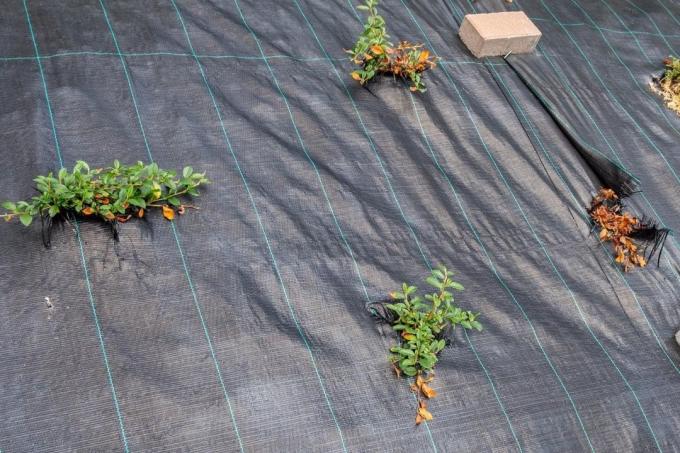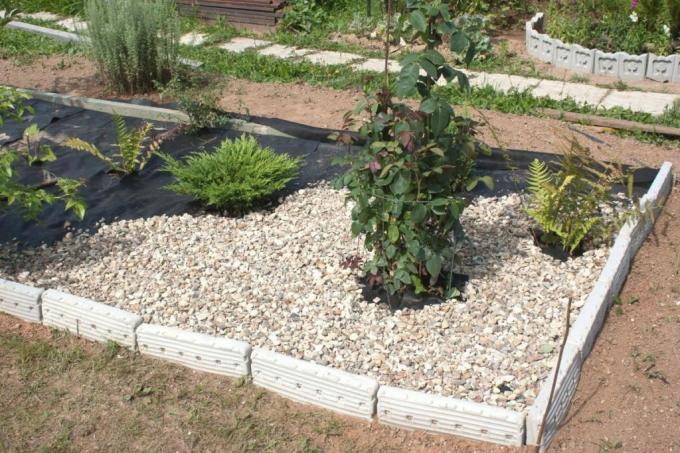
table of contents
- Advantages and disadvantages
- Create paths
- Fleece for gravel gardens
- Differences to the rock garden
- Near-natural gravel beds
- frequently asked Questions
Who areas resp. Paths designed with gravel and crushed stone often use a weed fleece as a separating layer. A fleece does not make sense for all surfaces and it does not protect against weed growth.
In a nutshell
- Plan the use of weed control in advance
- Fleece can encourage the colonization of pests
- Fleece as a root barrier against weeds
- Weed fleece as a base for new plants with backfill
- near-natural gravel gardens without fleece as a root barrier
Advantages and disadvantages
Gravel and gravel in the garden are often split, because many see advantages in simple maintenance, but the fleece can also cause problems. Gravel surfaces are usually laid out in such a way that the bottom layer forms a fleece that blocks out root weeds. The application for this purpose makes perfect sense in some cases.

Use is advantageous for:
- Areas with root weeds
- Areas that lay fallow for a long time
- Risk of other plants growing into the area
However, the weed control does not only have positive sides, because it promotes the colonization of pests, for example. These include voles, for example. You should therefore consider beforehand whether the fleece is helpful or whether it can possibly cause more damage.
Note: Weed control only protect existing root weeds. They do not prevent new weeds from developing from seeds above.
Create paths
It is helpful if you use a weed control when creating new paths. Here the fleece takes on a double function, because it also prevents the loose material from being carried out of the intended area. The advantage of the fleece is that it is flexible and that you can create not only straight paths, but also winding paths through the garden.
Fleece for gravel gardens
Gravel gardens are trendy because they look tidy and have clear lines. It is entirely possible to use a fleece for a gravel garden, but if plants are used, the fleece must be cut open at this point. It is important that the fleece is cut generously, because the plants not only need space to grow, but the water supply must be ensured.
Many weed control fabrics are permeable to water, but it takes time for the water to really seep through. As a result, it can happen that a large part evaporates on the surface and the plants in such areas may have too little water.
In gravel gardens, a fleece has other disadvantages such as:

- Weeds are difficult to remove on the surface
- Holes in the fleece encourage weed growth
- Holes are usually difficult to repair
- Leaves can only be removed with a leaf blower
Differences to the rock garden
Gravel gardens and Rock gardens do not have much in common apart from the rock, but are often falsely equated. You can also use a fleece as a root barrier for a rock garden. However, a thick layer of substrate is poured on top, where the plants for the rock garden will later be planted.
It is important that the fleece only serves as a barrier for plants that have a shallow root. Otherwise you would have to cut into the fleece again so that it can grow through. You can apply a layer of substrate of any thickness to the fleece. It should be at least 8 cm thick.
You usually create rock gardens on a slight slope. If a fleece is used as a separating layer, additional points must therefore be observed:
- Fix the fleece with large stones or suitable hooks
- Water must be able to run off
- For large areas, a fixation every 2-3 m offers additional stability
If the substrate is applied to the fleece, the problem usually arises that on a slope, the substrate slips away on the smooth surface. Additional barriers made of stone, for example, prevent the substrate from slipping and offer the plants additional stability, especially at the beginning.
Near-natural gravel beds
Gravel and crushed stone can become a valuable biotope in the garden. In addition to ornamental gardens that you design with this material, you can also use it to create a so-called ruderal area. These areas provide a habitat for a large number of animals and plants.

Weed control has no place in a near-natural gravel bed. The aim of such beds is that they provide a habitat for certain plants that also need contact with a layer of soil. It is wanted and even desired that they continue to multiply there or, in the best case, suitable further plants will settle there themselves.
Tip: Near-natural gravel beds are much easier to maintain than gravel gardens, because they can simply be mowed with the lawnmower at the highest cutting height in autumn.
frequently asked Questions
The durability depends on the strength and the load. Fleece under gravel paths does not last as long as in a bed due to the load.
An old weed fleece is disposed of in the residual waste.
Weeds that have settled in the layer above the fleece can be removed manually by weeding out, for example. You should refrain from using devices so that you do not damage the fleece.
